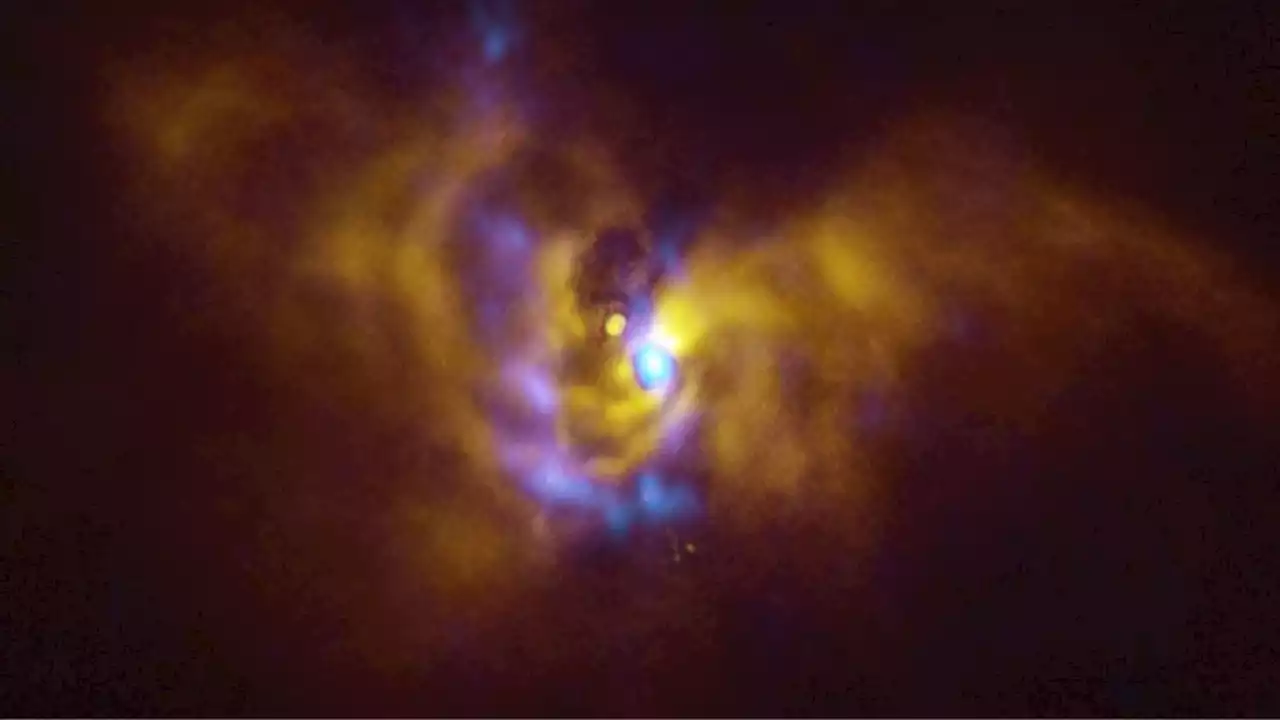Robert Lea is a science journalist in the U.K. whose articles have been published in Physics World, New Scientist, Astronomy Magazine, All About Space, Newsweek and ZME Science. He also writes about science communication for Elsevier and the European Journal of Physics. Rob holds a bachelor of science degree in physics and astronomy from the U.K.’s Open University. Follow him on Twitter @sciencef1rst.
Astronomers first turned their attention to the young star in 2014 when it unexpectedly brightened by about 20 times its usual magnitude. Observations with the VLT instrument Spectro-Polarimetric High-contrast Exoplanet REsearch observations were taken shortly after this outburst of brightness, with the instrument able to catch an unprecedented level of detail in the system.
This showed material orbiting V960 Mon is forming a series of intricate spiral arms that stretch for distances greater than the entire V960 Mon appears as a golden cloud with a bird-like shape in images from the VLT the blue glow of gas seen by ALMAThis finding was followed up when astronomers observed V960 Mon with ALMA.
"With ALMA, it became apparent that the spiral arms are undergoing fragmentation, resulting in the formation of clumps with masses akin to those of planets," Zurlo said.Astronomers suggest two avenues that gas giant planets could take to form. The first is core accretion, which sees dust grains gather to cover a rocky inner core. The second is gravitational instability, in which over-dense patches of a protoplanetary disk of gas and dust around a star collapse.
Scientists have seen hints at core accretion before, but the combined images from ALMA and SPHERE give astronomers a hint at the first observational evidence for this latter gas giant formation mechanism. "No one had ever seen a real observation of gravitational instability happening at planetary scales — until now," researcher leader and University of Santiago, Chile, scientist Philipp Weber said.
United States Latest News, United States Headlines
Similar News:You can also read news stories similar to this one that we have collected from other news sources.
 Unusual galaxy cluster is an island of tranquility in the chaotic early universeRobert Lea is a science journalist in the U.K. whose articles have been published in Physics World, New Scientist, Astronomy Magazine, All About Space, Newsweek and ZME Science. He also writes about science communication for Elsevier and the European Journal of Physics. Rob holds a bachelor of science degree in physics and astronomy from the U.K.’s Open University. Follow him on Twitter sciencef1rst.
Unusual galaxy cluster is an island of tranquility in the chaotic early universeRobert Lea is a science journalist in the U.K. whose articles have been published in Physics World, New Scientist, Astronomy Magazine, All About Space, Newsweek and ZME Science. He also writes about science communication for Elsevier and the European Journal of Physics. Rob holds a bachelor of science degree in physics and astronomy from the U.K.’s Open University. Follow him on Twitter sciencef1rst.
Read more »
 A cosmic chameleon reveals its true colors in stunning infrared image (photo)Infrared imaging offers a gorgeous view of a highly active stellar nursery.
A cosmic chameleon reveals its true colors in stunning infrared image (photo)Infrared imaging offers a gorgeous view of a highly active stellar nursery.
Read more »
 J. Ernest Wilkins Jr. was a Manhattan Project standout despite racism | Science NewsJ. Ernest Wilkins Jr. had a small role in Oppenheimer. But he was a standout in the Manhattan Project, achieving greatness in an era of rampant discrimination.
J. Ernest Wilkins Jr. was a Manhattan Project standout despite racism | Science NewsJ. Ernest Wilkins Jr. had a small role in Oppenheimer. But he was a standout in the Manhattan Project, achieving greatness in an era of rampant discrimination.
Read more »
 NCT DREAM’s “ISTJ” Achieves 3rd Highest 1st-Week Sales Of Any Album In Hanteo HistoryNCTDREAM's 'ISTJ' Achieves 3rd Highest 1st-Week Sales Of Any Album In Hanteo History
NCT DREAM’s “ISTJ” Achieves 3rd Highest 1st-Week Sales Of Any Album In Hanteo HistoryNCTDREAM's 'ISTJ' Achieves 3rd Highest 1st-Week Sales Of Any Album In Hanteo History
Read more »
 Update: KQ’s Rookie Boy Group xikers Teases 1st-Ever Comeback WIth New Poster For “Koong”Update: KQ’s Rookie Boy Group xikers Teases 1st-Ever Comeback WIth New Poster For “Koong”
Update: KQ’s Rookie Boy Group xikers Teases 1st-Ever Comeback WIth New Poster For “Koong”Update: KQ’s Rookie Boy Group xikers Teases 1st-Ever Comeback WIth New Poster For “Koong”
Read more »
